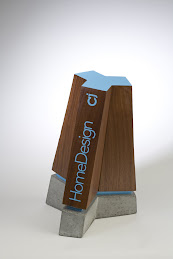The Buffon residence project is coming along. The project slowed up a bit in August because I was traveling and since the owner is months away from moving in, I can take it easy. The two larger test pieces are finished. I have been using the eco tuff epoxy for smaller pieces with success. When I put it on these pieces it just didn't look that great. Even with a foam roller it had bumps and the surface was very shiny. This kitchen has halogen spot lights which showed every smudge and bottle mark. So I embarked on a mission to bring the shine down. Unfortunately the epoxy is so hard the sanding is out of the question. So I ended up trying lots of difference sealers, again. Well, I found one I like which produces a satin finish, is easy to put on, and very durable. What is this amazing sealer, drumroooooool, regular old Spar Urethane. Yep, the same stuff you can buy at the hardware store. Funny, on the can it says countertops are one of the uses. It fits the bill, easy to apply, consistent texture, non-yellowing, and very hard. From here out two coats of satin urethane and a coat of wax will be the standard. It does also bring out the wet look color just like epoxy and has a higher heat rating than epoxy. Ok, that problem is solved and in a pretty easy manner.
They look very industrial, which while cool isn't really what I was going for. Part of the reason is that it was 95 plus when we placed these and the face set very quickly. Back, kind of, to the drawing board.
So what's the deal with new frontiers? Well I have been playing with a super absorbent polymer for eliminating curing on pavements and it works great. Think super duper baby diaper gel. This stuff will soak up 2000 times its weight in water and doesn't let go until the cement needs it. It eliminates plastic or water curing and generally improves all concrete properties. The stove section was placed last Friday, same mix as before but with the magic juice. It sat a couple days before stripping and flipping. Funny, this piece is 8 ft long and I flipped it by myself no problems. Below is a shot after flipping without any finishing. The texture was great, consistent, with very minimal bug holes.
After a quick wet hand polish with a scotch brite pad. I won't even have to use the grinder/polisher on this piece. All it will take is a hand scrubbing, slurry, and a second hand scrubbing before sealing.
Seems like this will work. Each of the remaining pieces will be completed probably one per week due to space constraints. Stay tuned. If you have questions on the specifics let me know.








Can you divulge any more information on the super absorbent polymer (AKA super duper baby diaper gel) as far as consumer availability and the specifications on how to include it in a mix? Also, does it affect the workability of the mix?
ReplyDeleteHi, great blog. I'm intrigued as to what the 'super absorbent polymer for eliminating curing on pavements' is...
ReplyDeleteMany thanks
I will have a post shortly just about SAP and where to get it.
ReplyDeletejk
Hi, I'm looking to seal a concrete vanity and interested in using the Spar Urethane for my sealer. How did you apply the sealer? Was it rolled on or sprayed on? I was also told that sometimes it may "scratch", how did you avoid this? Thanks!
ReplyDeleteI have been rolling on two coats of urethane with a foam roller. Spar urethane is normally used on hardwood floors and is very hard. It has some of the best scratch resistance of any of the sealers I have tried. The abrasion resistance of the spar urethane is similar to the industrial floor epoxy I had been using. We push beer bottles and tools across it without seeing any scratches. Just make sure it has cured at least 24 hours in 70 degree conditions before testing how hard it is.
ReplyDeleteSingle part polyurethane is softer and can scratch. That did not perform very well in the abrasion testing.
So like the Minwax Helmsman Spar Urethane ? Do you have moisture and possible de lam issues. Expansion and contraction are totally different. sorry for all the questions...
ReplyDeleteYes, minwax spar urethane. You need to make sure the surface is clean and dry and the second coat needs to be within 24 hours of the first coat going on. Rubbing the surface with a scotch brite pad gives some texture for the urethane to bond. It soaks into the dry concrete, the only delam issues that could happen is if wax or oil gets between the first and second coats. This would be a problem for any other sealers too.
ReplyDeleteJohn would u mind if I passed along this info on a forum I'm also discussing sealers on ? And I would like to give reference to your blog as well ..
ReplyDeleteGo right ahead. Feel free to pass on anything helpful.
ReplyDelete